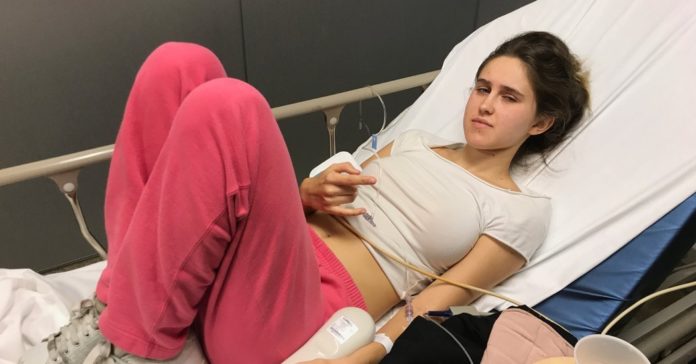The antibiotics were immediately stopped, as they have been linked to an increased likelihood of developing dangerous complications from the bacterial infection. But by then the signs were already beginning to show. My platelet count was dropping at a dangerous rate, my kidney function had begun to falter. I had developed hemolytic uremic syndrome, a life-threatening complication of E. coli infection.
I was treated to the first ambulance ride of my life to transfer to Georgetown University Hospital, where I would remain hospitalized for the next 33 days.
In the critical care unit, I was strapped into several machines that would monitor my vitals. The next morning, a doctor came in and inserted a temporary access catheter into the right side of my neck. I was wheeled down to a lower level of the hospital for the first of my six plasmapheresis treatments, a particularly draining experience in which blood was removed, cleaned and then returned to my body via a large tube in my neck.
A team of hematologists, nephrologists, infectious disease specialists and a general physician visited every morning. They’d ask, “How are you feeling, Frances?”
Everyone knows me as Maggie, but in an annoying quirk of my hospitalization, my medical records and wristband all bear my legal name, Frances. “One name for each grandmother,” my mom reasoned when my parents decided to christen me Frances Margaret. An unintended consequence of their thoughtfulness is that I have spent much of my life correcting people who called me Frances. “It’s Maggie, short for Margaret, my middle name,” I said.
But in the hospital, it helped to have a second persona. Frances put on a brave face during the hours of treatment in sterilized facilities, while Maggie drew inward, refusing books and music or anything else that reminded me of who I was outside the hospital walls. From where I sat, pinned to machines by the needles in my veins, in a body I hardly recognized, and with a label on my wrist displaying a name that wasn’t mine, I couldn’t be sure that it was me this was really happening to. I listened patiently as doctors and nurses and technicians came into my room to offer Frances their well wishes, draw blood, or discuss what medications she should take or what procedures might make her body strong once more.
During my first week of hospitalization, the kidney doctors debated whether to begin the dialysis process, sticking to the typical “wait-and-see” approach. But by the end of the week there was no question. I had gained 30 pounds from all the excess fluid and could hardly stand up and walk on my own. I began my first of many three-hour-long dialysis treatments, where they siphoned off the liquid, doing the work of my kidneys that I had so long taken for granted.
I had mostly avoided social media since getting sick, but one day, I logged onto Facebook to see that across the country, people I knew and people I didn’t — a pair of girls I once babysat for, a football team in Rhode Island — were praying for Maggie, hoping Maggie pulled through. The more people that worried about me, the sicker I must be, I thought.
The dialysis continued for three weeks with tiny but measurable results. My platelet counts began to climb, and I started to pee again. But it wasn’t enough to impress the nephrologists, who decided to surgically place a catheter in my chest, to both drain and administer fluids.
Doctors began discussing a kidney transplant and temporary home-care dialysis training. I was sent home for a weekend to rest up before my first training for an eventual dialysis machine to be brought to my parents’ house, but we didn’t get that far. I went to bed after dinner and woke up in an ambulance racing back to the hospital I had just left. My blood pressure had begun a dangerous rise as my kidneys began to start working again, and I had the first of three seizures that night.
The next few days are mostly lost from memory, but some hazy images survive. Waking up in a tube to discover I was getting an M.R.I. A nurse delicately pulling glue from my hair from where the technicians had inserted sensors. My hospital bed being wheeled out of the operating room after the catheter was removed from inside my chest.The sharp lines of the white hallway walls, every corner offering a shadowy descent into someone else’s hospital story.
Through my half-closed lids, I see a rare pocket of sunlight at the end of the corridor. Briefly I feel the warmth of its gaze as we trek on through the seemingly endless maze of the hospital’s hallways and locked doors. The dryness in my mouth is the first clue that I’m back in my body, that my kidneys have begun to heal themselves at an admirable pace.
My mom finds me soon after, as I’m attempting to drink water from a clear plastic straw. She reaches out and holds it in place. The nurse comes in to tell us that it all went well, that Frances’s vitals look good, that we’ll be ready to transfer her back upstairs soon.
“She goes by Maggie,” my mom says.
“Oh, I’m sorry,” the nurse says, glancing down at her chart before stepping back into the hall, “Maggie.”
I turn to smile at my mom. It doesn’t matter what they call me anymore. She holds my hand as we’re guided back upstairs to my hospital room for the last time.
Sometimes now, in my apartment, on the train, while walking down a crowded street, I like to run my fingers over the fresh scars lining my collarbone. Now that the toxins have left my system, now that my body has built itself back up, I have only the scars to remind me that Frances was tested, that Maggie survived. That it really happened to me.
Source : Nytimes











